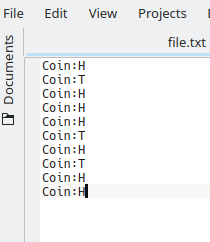Python program to Count the Number of occurrences of a key-value pair in a text file
Last Updated :
31 Jul, 2023
Given a text file of key-value pairs. The task is to count the number of occurrences of the key-value pairs in the file with Python
Program to Count the occurrences of a key-value pair
- Naive Approach to Count the Occurrences of a key-value Pair
- Using Python built-in collections.Counter
- Using regular expressions (re module)
Text file:

Naive Approach to Count the Occurrences of a key-value Pair
The approach is very simple. Maintain another dictionary (say d) that will store the count of occurrence of each key-value pair of the file. Store the key-value pair of the text file as a key in the dictionary. Now iterate through the key-value pairs of the file. If the pair is present in the dictionary then increment the value of that pair by one otherwise insert the pair and set its value to one. Below is the implementation.
Python3
f = open("file.txt", "r")
d = dict()
for res in f:
res = res.strip()
res = res.lower()
lines = res.split()
for line in lines:
if line in d:
d[line] = d[line]+1
else:
d[line] = 1
f.close()
for key in list(d.keys()):
print("The count of {} is {}".format(key,d[key]))
|
Output : 
Time complexity: O(n*m), where n is the number of lines in the text file and m is the number of words in each line.
Auxiliary space: O(k), where k is the number of unique key-value pairs in the text file.
Count Occurrences of a Value in a Python Dictionary using collections.Counter
This method utilizes the collections.Counter class, which is a powerful tool for counting occurrences of elements in a collection.
Python3
from collections import Counter
def count_key_value_pairs(file_path, key, value):
with open(file_path, 'r') as file:
lines = file.readlines()
count = 0
for line in lines:
line_key, line_value = line.strip().split('=')
if line_key == key and line_value == value:
count += 1
return count
if __name__ == "__main__":
file_path = "path/to/your/text_file.txt"
key_to_find = "your_key"
value_to_find = "your_value"
occurrences = count_key_value_pairs(file_path, key_to_find, value_to_find)
print(f"Number of occurrences of '{key_to_find}={value_to_find}': {occurrences}")
|
Output:

Time complexity: of O(N * K)
Space complexity: of O(N)
Count Occurrences of a Value in a Python Dictionary using RegEx
This method utilizes the re module to search for key-value pairs in the text file using regular expressions.
Python3
import re
def count_key_value_pairs(file_path, key, value):
with open(file_path, 'r') as file:
data = file.read()
pattern = r'\b{}={}\b'.format(re.escape(key), re.escape(value))
occurrences = len(re.findall(pattern, data))
return occurrences
if __name__ == "__main__":
file_path = "path/to/your/text_file.txt"
key_to_find = "your_key"
value_to_find = "your_value"
occurrences = count_key_value_pairs(file_path, key_to_find, value_to_find)
print(f"Number of occurrences of '{key_to_find}={value_to_find}': {occurrences}")
|
Output:

Time complexity: O(N)
Space complexity: O(N).
Like Article
Suggest improvement
Share your thoughts in the comments
Please Login to comment...